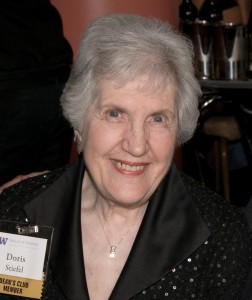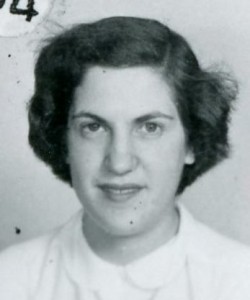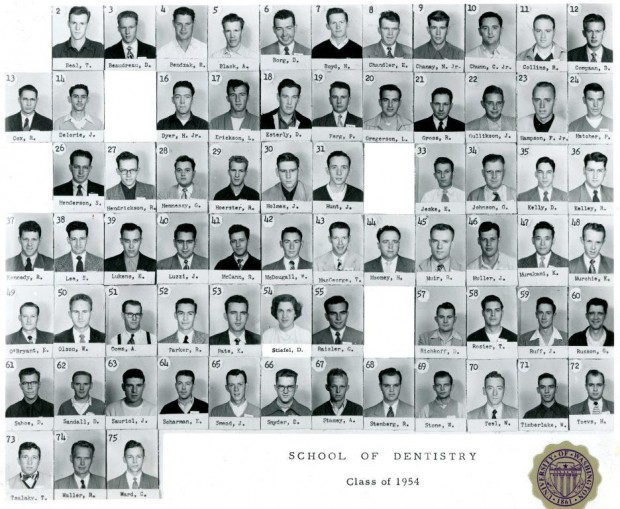 Dr. Doris Stiefel, born into a Jewish family in Germany, was 9 when her family escaped the Nazi terror and made it to England in 1938. After living there for 10 years and completing two years of dental school, she came to Seattle with her family in 1948 to join relatives here. She became the first woman graduate of the School of Dentistry in 1954 and received her master’s degree in oral biology in 1971. As director of the Dental Education in Care of Persons with Disabilities (DECOD) program from 1975 to her retirement in 1994, she played a vital role in building DECOD into an internationally recognized center of patient care and professional education. Here she recalls her pre-doctoral student days.
Dr. Doris Stiefel, born into a Jewish family in Germany, was 9 when her family escaped the Nazi terror and made it to England in 1938. After living there for 10 years and completing two years of dental school, she came to Seattle with her family in 1948 to join relatives here. She became the first woman graduate of the School of Dentistry in 1954 and received her master’s degree in oral biology in 1971. As director of the Dental Education in Care of Persons with Disabilities (DECOD) program from 1975 to her retirement in 1994, she played a vital role in building DECOD into an internationally recognized center of patient care and professional education. Here she recalls her pre-doctoral student days.
Early training and the move to America: I started dental school in England at the Royal Dental Hospital (part of the University of London system) in 1946 at the age of 17, because in accordance with the British system one went straight from high school to dental school or other professional school.
Most of my father’s family were in the United States. In 1947 his sister and her husband came and visited from Seattle; they brought us brochures of the beautiful Northwest and Seattle and urged us to make the final move. We debated – I was an only child and I was in the middle of my dental school career. Even if I finished up my degree program in England, I would have to take three more years in the U.S. to qualify to take the boards, so we decided to make the break and take a big chance. We couldn’t turn down the opportunity to come here, but it was not at all certain that I could resume my dental studies here.
The UW dental school was brand new at the time. I had to get sufficient pre-dental certifications and spent five quarters on upper campus to earn enough credits to qualify to apply to dental school here. The extra bit of education didn’t hurt me, because I was really missing the social sciences and liberal arts. In high school in England, all I had taken the last two years was chemistry, physics and biology.
I applied to dental school here at the UW and also to Northwestern. I got the acceptance from Northwestern first. My father was very upset at the thought of his daughter going off to Chicago, and luckily I got accepted here. I remember the interview quite well. It was formidable – all of the faculty lined up on one side of the table, with me on the other. The acceptance rate was about one out of 10 at the time. The common thinking was that a man was more likely than a woman to become a fully contributing member of the profession, and the dental school took a big leap by accepting me.
School of Dentistry challenges: The dental curriculum was challenging and strenuous all around for everybody. The fact that I had already taken some of the basic courses such as anatomy made things a little bit easier for me. Some of the other courses proved more difficult. Biochemistry was on a completely different level than I had had.
I remember all the dental instructors as polite, but some were more encouraging than others, and that shaped my preferences and ultimately the direction of my career. During my clinical years I became more interested in periodontology and endodontics. In my class, many of the students were veterans. They were more mature – many were married and had families. Dental school was serious business. It had to be for everyone, if you wanted to survive.

The gender issue: I got engaged the summer before I started dental school. Ernie and I got married after my first quarter – Dec. 23, right in the middle of winter vacation. I had started dental school as Doris Pintus and of course I didn’t dare to tell anyone that I was engaged to be married. I would have never gotten in. So I kept it very quiet. Everybody was surprised when I turned up with a wedding ring at the beginning of winter quarter and changed my last name to Stiefel.
Being married, in many ways, made life in dental school much easier. I didn’t have to worry about social relationships with the guys, and I was on a par with the large number of my classmates who were married. It helped immensely that I had a very supportive husband. In general, I think it takes a supportive parent or spouse to ease life through dental school. At that time dentistry was a very tough course of study. I don’t know what it is like now, but I have a feeling it is probably not as strenuous as it was then. The curricular load the first two years was extremely heavy, and even in the clinical years we spent many an evening in the lab waxing and casting restorations.
Obviously I stood out, and I’m not sure how fully accepted I was. I was somewhat disadvantaged – for one thing, the men had their fraternities, which were very supportive both academically and socially, and those were closed to me. There was never even a thought of accepting a woman. But other than that, the guys for the most part were friendly. The class of ’54 was a great class with many high achievers. We sat in alphabetical order, so you got to know the fellows around you in your part of the alphabet, but since my name began with S, those at the beginning of the alphabet I had less contact with.
Being the first female student in the school made for some interesting moments. On the first day, there was consternation: What locker room was I going to use? Sharing the men’s locker room was out of the question, and they didn’t know what to do. So they put me with the dental hygienists, which worked out fine. I became friends with several in the first student classes there, and it was a good arrangement. Later, when it came time to begin the clinical part of the curriculum, the question of uniform came up. The faculty apparently felt that the men’s barber-style gown was unbecoming for a woman. I’m not quite sure why – because they had a high collar? I think it was Dr. Stibbs who had them design a conservative white jacket with a little Peter Pan collar for me– supposedly a little more feminine.
I don’t recall any patient objecting to being treated by a woman student. However, practice opportunities were certainly more limited than they are today. After graduation I felt fortunate to have an associate part-time practice during the years we were starting a family.
I never expected my career to take the direction that it did. I knew that I wanted to get an advanced degree and go into a dental specialty. Oral Biology was welcoming, and research appealed to me. But I missed the clinical contact with patients. Then I became involved with the DECOD program and switched to the Oral Medicine Department.
It turned out to be an interesting career. If I would have had more encouragement in one of the clinical specialties, I probably would have enjoyed that too. It might not have been quite as rewarding as the DECOD program, though.
